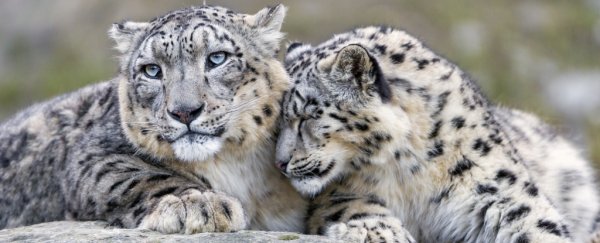The snow leopard's conservation status just got knocked down a notch, and the big cat is now officially no longer endangered.
On the International Union for Conservation of Nature's Red List of Threatened Species, the snow leopard is now considered Vulnerable - still under threat, just not quite as dire as the Endangered status.
To be considered officially endangered, a species has to number fewer than 2500 individuals, declining at a rate of over 20 percent over two generations. The snow leopard does not meet these criteria - but, according to the IUCN's revised snow leopard entry, it's possible it never did.
It asserts that the previous Endangered status was based on an erroneous assessment in 2008.
 IUCN
IUCN
"The previous assessment in 2008 (Endangered C1) was based on <2,500 mature individuals and an estimated decline of 20 percent over 16 years (two generations)," the IUCN wrote.
"However, in that assessment, effective population size (Ne) was incorrectly used as a surrogate for 'mature individuals' and produces a lower figure (50 percent of the adult population of 4,080). Therefore, the species should have been listed as Vulnerable in 2008."
The entry also mentions that poaching for their rich fur, considered a risk factor in the predicted 20 percent decline, had dropped.
The snow leopard, rarely seen in the wild, lives across 12 countries in Central Asia, and its numbers, according to the IUCN, are estimated to be between 7367 and 7884 individuals.
The organisation also asserts that concerted conservation efforts around the globe have improved the outlook for the snow leopard, which is under threat from poaching and habitat loss due to climate change and human settlement expansion.
Conservation organisation The Snow Leopard Trust, which has been working to protect the snow leopard since 1981, opposes the IUCN's ruling.
"We believe the best available science does not justify the status change, and that it could have serious consequences for the species," the Trust wrote in a blog post.
"In the case of the snow leopard, less than 2 percent of the species' range has ever been sampled for abundance using reliable techniques such as camera traps or genetic analysis. In addition, the limited solid data that is available is biased toward high-density areas."
"The new assessment behind the status change of the snow leopard does not improve on this data and appears to use methodologies - such as asking people how many snow leopards they think exist in any area - that are not recognised as scientifically valid for estimating populations."
The trust is filing a petition with the IUCN to restore the snow leopard's Endangered status, and will be working with the community to collect more accurate data on snow leopard populations.
If the petition to restore the animals' status fails, the Trust hopes this data will help provide a more accurate assessment when it is due in five years.
"The snow leopard remains under acute threat," The Snow Leopard Trust said.
